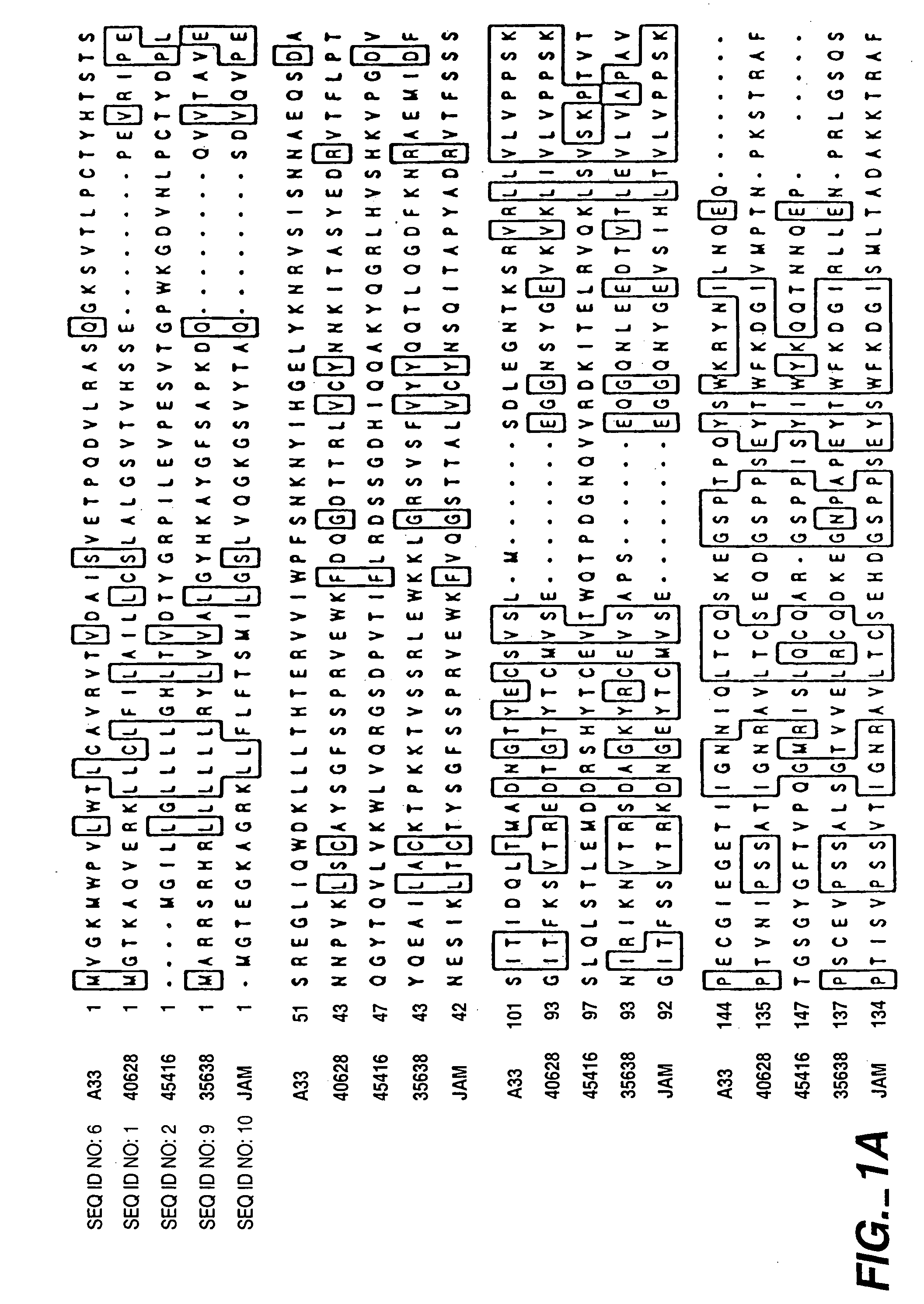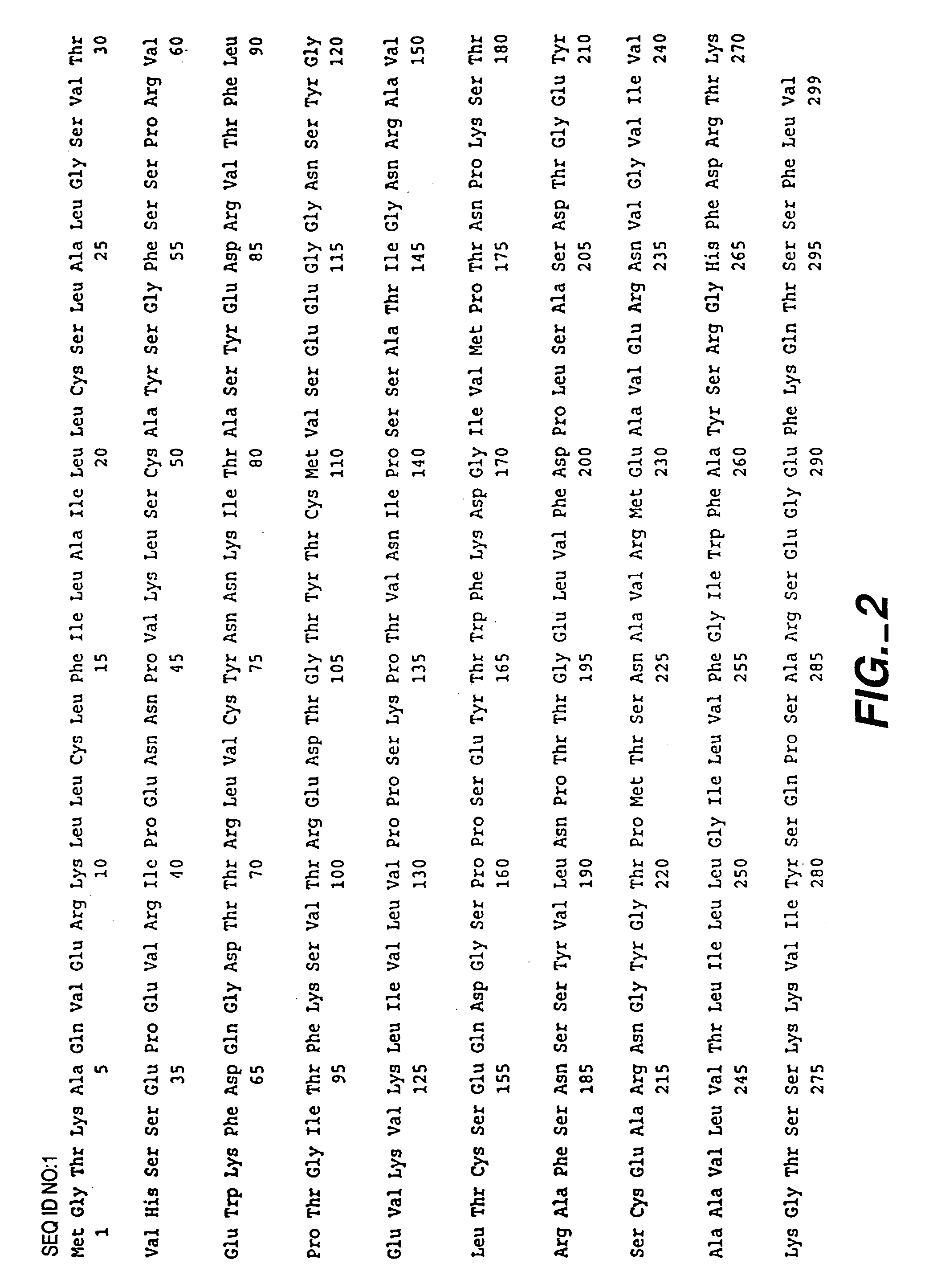PRO362 polypeptides
a polypeptide and pro362 technology, applied in the field of pro362 polypeptides, can solve the problems of difficult to precisely determine which of the two, cd also has a high rate of reoccurrence, and uc patients further have a substantially increased risk of colorectal cancer, so as to enhance the inflammatory response, and suppress the inflammatory response
- Summary
- Abstract
- Description
- Claims
- Application Information
AI Technical Summary
Benefits of technology
Problems solved by technology
Method used
Image
Examples
example 1
Isolation of cDNA Clones Encoding Human PRO301
[0312]The extracellular domain (ECD) sequences (including the secretion signal sequence, if any) from about 950 known secreted proteins from the Swiss-Prot public database were used to search EST databases. The EST databases included public EST databases (e.g., GenBank), a proprietary EST database (LIFESEQ®, Incyte Pharmaceuticals, Palo Alto, Calif.). The search was performed using the computer program BLAST or BLAST2 [Altschul et al., Methods in Enzymology, 266:460-480 (1996)] as a comparison of the ECD protein sequences to.a 6 frame translation of the EST sequences. Those comparisons resulting in a BLAST score of 70 (or in some cases, 90) or greater that did not encode known proteins were clustered and assembled into consensus DNA sequences with the program “phrap” (Phil Green, University of Washington, Seattle, Wash.).
[0313]A consensus DNA sequence encoding DNA35936 was assembled using phrap. In some cases, the consensus DNA sequence ...
example 2
Isolation of cDNA Clones Encoding Human PRO362
[0320]The extracellular domain (ECD) sequences (including the secretion signal, if any) of about 950 known secreted proteins from the Swiss-Prot public protein database were used to search expressed sequences tag (EST) databases. The EST databases included public EST databases (e.g., GenBank) and a proprietary EST DNA database (LIFESEQ®, Incyte Pharmaceuticals, Palo Alto, Calif.). The search was performed using the computer program BLAST or BLAST-2 (e.g., Altshul et al., Methods in Enzymology 266: 460-480 (1996)) as a comparison of the ECD protein sequences to a 6 frame translation of the EST sequence. Those comparisons resulting in a BLAST score 70 (or in some cases 90) or greater that did not encode known proteins were clustered and assembled into consensus DNA sequences with the program “phrap” (Phil Green, University of Washington, Seattle, Wash.
[0321]A consensus DNA sequence was assembled relative to other EST sequences using phrap....
example 3
Isolation of cDNA Clones Encoding Human PRO245
[0330]The extracellular domain (ECD) sequences (including the secretion signal, if any) of about 950 known secreted proteins from the Swiss-Prot public protein database were used to search expressed sequences tag (EST) databases. The EST databases included public EST databases (e.g., GenBank) and a proprietary EST DNA database (LIFESEQ®, Incyte Pharmaceuticals, Palo Alto, Calif.). The search was performed using the computer program BLAST or BLAST-2 (e.g., Altshul et al., Methods in Enzymology 266: 460480 (1996)) as a comparison of the ECD protein sequences to a 6 frame translation of the EST sequence. Those comparisons resulting in a BLAST score 70 (or in some cases 90) or greater that did not encode known proteins were clustered and assembled into consensus DNA sequences with the program “phrap” (Phil Green, University of Washington, Seattle, Wash.
[0331]A consensus DNA sequence was assembled relative to other EST sequences, wherein the ...
PUM
| Property | Measurement | Unit |
|---|---|---|
| temperature | aaaaa | aaaaa |
| pH | aaaaa | aaaaa |
| pH | aaaaa | aaaaa |
Abstract
Description
Claims
Application Information
 Login to View More
Login to View More - R&D
- Intellectual Property
- Life Sciences
- Materials
- Tech Scout
- Unparalleled Data Quality
- Higher Quality Content
- 60% Fewer Hallucinations
Browse by: Latest US Patents, China's latest patents, Technical Efficacy Thesaurus, Application Domain, Technology Topic, Popular Technical Reports.
© 2025 PatSnap. All rights reserved.Legal|Privacy policy|Modern Slavery Act Transparency Statement|Sitemap|About US| Contact US: help@patsnap.com



